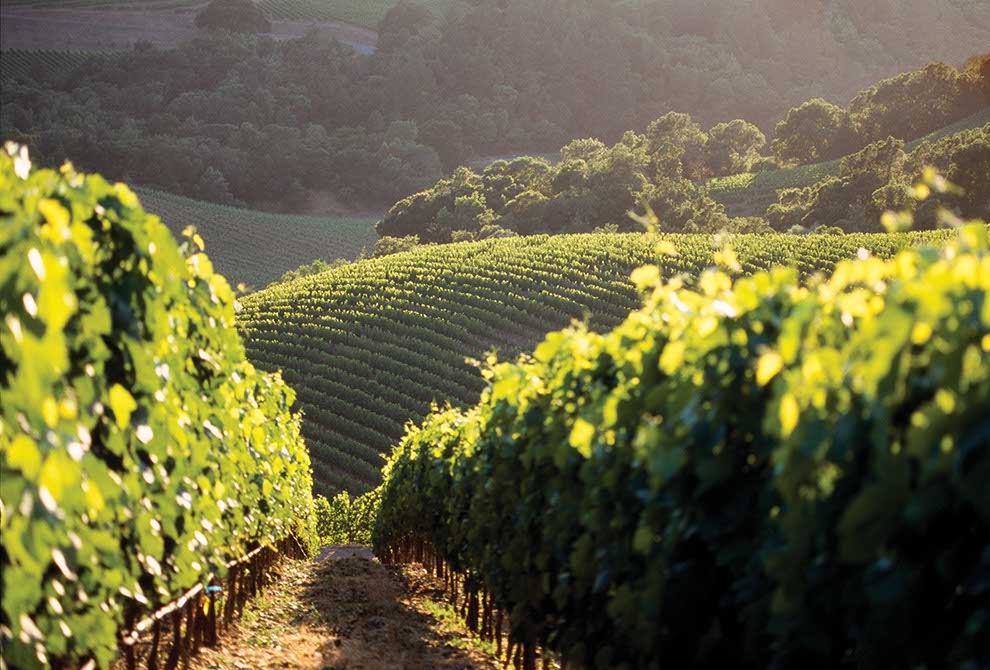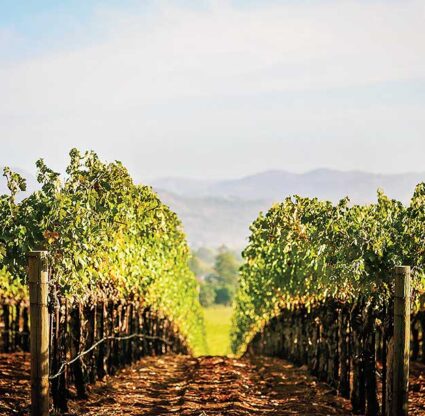When visionary vintner Bill Harlan visited the Premier Cru vineyards of Bordeaux, an undulating matrix of widely varying soil and terroir, in the 1980s, it was the beginning of wine excellence in the United States. Napa Valley has no First Growth nomenclature, a term applied to the very best of the best—only five Bordeaux estates carry the name—but Bill knew that applying the rigors of the great French houses to Napa (and leaning into the sloping hillsides for grape production) could produce one of the greatest wines in the world.
Today, Harlan Estate’s 40 acres of vineyards in the western hills of Oakville produce mainly cabernet sauvignon, along with some merlot, cabernet franc and a tiny amount of petit verdot for Harlan’s two wines: the Proprietary Red and The Maiden. Now, the second-generation stewards of the estate, siblings Amanda and Will Harlan, can taste how their family’s wines have evolved over the past 40 years.
Though the family would never call their vintages ‘cult wines,’ the producer has become a lightning rod for serious wine drinkers and collectors. Year after year, limited production coupled with the richness that they coax from Bill’s old-growth plantings have redefined Napa reds and helped Harlan Estate’s wines become known as “California cult cabernets,” a testament of the deep expression of the grapes, of the valley and of the area’s unique terroir.
The cru concept, treating the different parcels as a collection of select vineyards, is applied throughout the property. The layout of the vines, planted in a horseshoe shape on hillsides around a central valley, dictates specialized production techniques. The first plantings were in hillside terraces. As the vineyard expanded and changed, so did the vines’ organization (partly for improvements in growing, partly for safety).
In one section, the terraces are bundled tightly together; in another, rows of vines are perfectly level, contoured to the hillsides’ shape. To protect from the afternoon sun in the warm climate, Harlan positions their vertical trellises with a northeast/southwest cant. Because of the hill’s soil variety, they irrigate across, rather than in vertical blocks, using a separate irrigation system for each row. The crews use their knowledge of the land, developed over years of walking the vineyard daily, to assess the vines’ needs and respond accordingly.
Will, who serves as the estate’s managing director, says they’re just scratching the surface of what their vines and bottles can become. As time rolls on, there are several constants: Harlan’s wines tend to be soft, yet full-bodied and fruit-forward. More recently, Harlan wines lean more into the notion of terroir, or evoking the vineyard’s sense of place. “The wine needs to be able to age, and it needs to be a true reflection of the place … so it has a distinct and inspiring story to tell,” Will says.
As the second generation to helm the estate, the brother-sister duo look to the past four decades to map the future. They reference the “200-year plan” their father, who has stepped away from daily operations, coined when his children were still teens. The vision isn’t a written manuscript, but more an ethos they embrace to continue building the winery with a legacy focus through projects that gain a deeper understanding of the land and what the vines can produce. After all, their father’s first vintage took 10 years to come to fruition. His patience paid off—Harlan wines, which have reached up to $700,000 for a 10-vintage vertical at auction, are now lauded as some of the most collectible from California and are known for their deep aging potential, up to 20 years. Legendary English wine critic Jancis Robinson called Harlan’s Proprietary Red one of the 10 best wines of the 20th century.
“Growth for most businesses is about size, but growth for us is about deepening our connection to the place and elevating our ability to translate that place into the wine,” Will says. While some family-run wineries in the area have sold to larger companies, Harlan remains staunchly independent and family-owned. As the faces of the brand, Will and his sister continue to show how Napa wine pioneers can help shape the future of California’s esteemed region.
The primary Harlan vineyards run a bit wild, with bears and mountain lions ambling between vines and a surrounding forest. Trees help keep the growing areas cooler but also make them more susceptible to wildfires, so Harlan employs an entire crew to care for the forest by clearing dead vegetation and tending to the ecosystem.
The site represents the family’s terroir-first mentality—tending the land with an eye on sustainability and respect for the tracts that produce the plush vintages. The verdant nature of the property also reflects the maverick (but respectful) mentality of next-gen producers like Will, who has blended magic among the younger vines for the BOND wines and launched the Promontory label on an untamed, isolated parcel on Oakville’s southwestern ridge. “It’s also this humbling, ongoing learning process that, in a couple of hundred years from now, many generations after us will have a much better grasp of what we have here,” Will says.
Part of evolving is keeping up with the times and engaging a new, younger audience. Harlan Estate reaches the next gen of oenophiles through The Mascot, a project that started as a blend of cabernet from younger vines that was poured and shared with family and friends. The wine was such a crowd-pleaser, they decided to bring it to market.“It’s a fantastic jumping-off point for people getting started on their journey in wine,” Will says. “It’s a blend, and not a single expression of a vineyard, and has a more approachable price point than Harlan Estate’s collector-worthy wines.”
Since Will and Amanda were children, their parents instilled in them the importance of philanthropy—in particular, emphasizing giving back to children in areas that make the most impact, such as education. The Harlan family has been part of the Naples Winter Wine Festival since the first year when festival co-founders Valerie Boyd and Jeff Gargiulo brought the Harlans on board. Will and Amanda plan to kick off the 40th anniversary of Harlan Estate at the festival. “We feel honored and privileged to be back, and we’ll make a big splash of celebration there with the wonderful people who have always been so inviting,” says Amanda, who oversees sales and marketing for the brand. She also runs the estate’s private club, The Napa Valley Reserve, where members access premium grapes, an all-star winemaking team and are assigned their own row in the vineyard. Members can be as hands-on as they’d like with their personal plot.
Everyone asks about the next project for Harlan Estate, but Will says, in some ways, he feels the winery is still in its early stages. “It takes many generations to understand a piece of land—it’s been a steep learning curve the past 40 years and it’s not tapering off,” he explains. “We’re trying to create this self-sustaining and well-balanced environment where we don’t have to come in and do very much.”
With viticulture, the Harlans are learning where they can ease off their hands-on involvement, by working with their managing director of winegrowing, Cory Empting, who has been with Harlan for more than two decades. Empting focuses on sustainable viticulture on multiple levels. Dry farming helps account for California’s frequent droughts, cover crops and no-till farming capture carbon in the soil to reduce greenhouse gas emissions, and bottle fermentation omits heat and yeast to allow the grapes to ferment independently, reducing energy consumption. Each decision becomes a pillar for the years to come. “For us, it’s always more about evolution than revolution in terms of who we, as the second generation, are,” he says. “We get to benefit from 40 years of history.”





